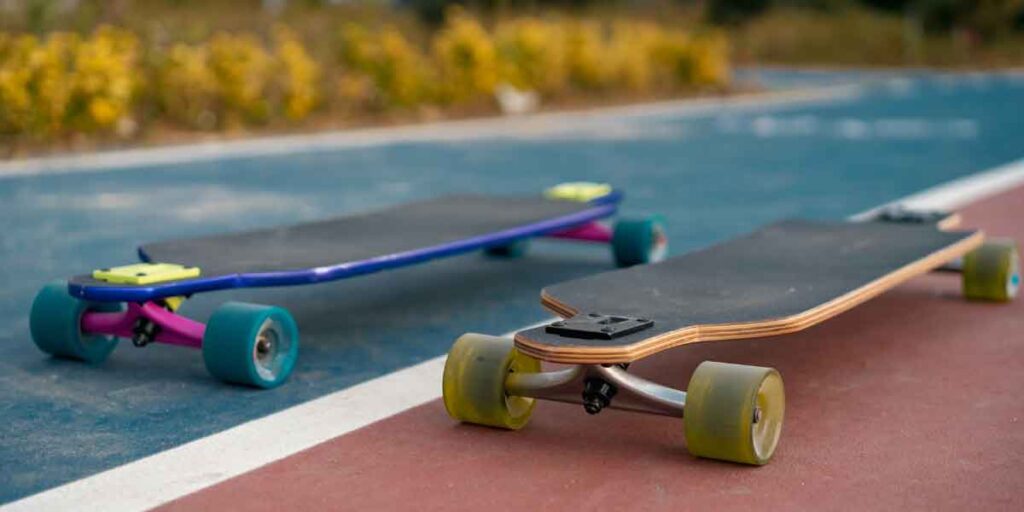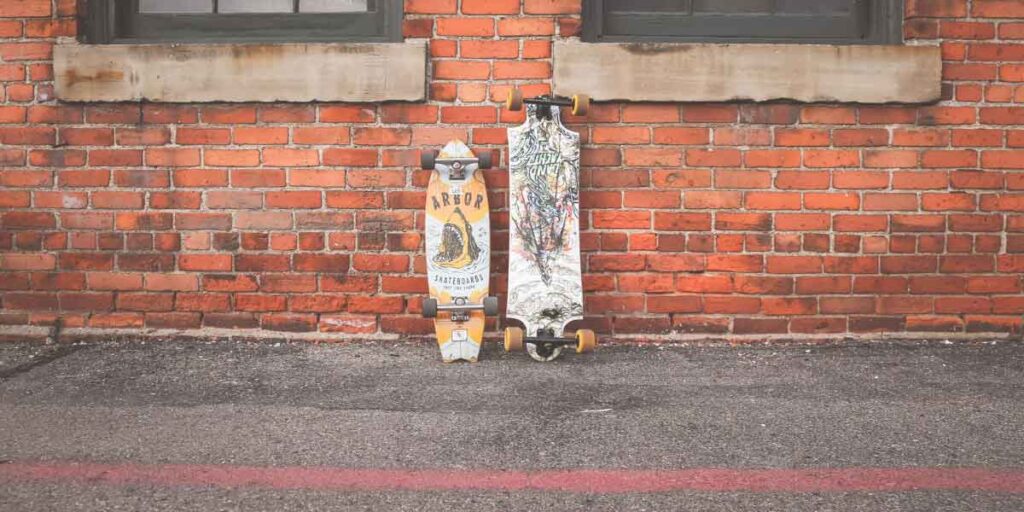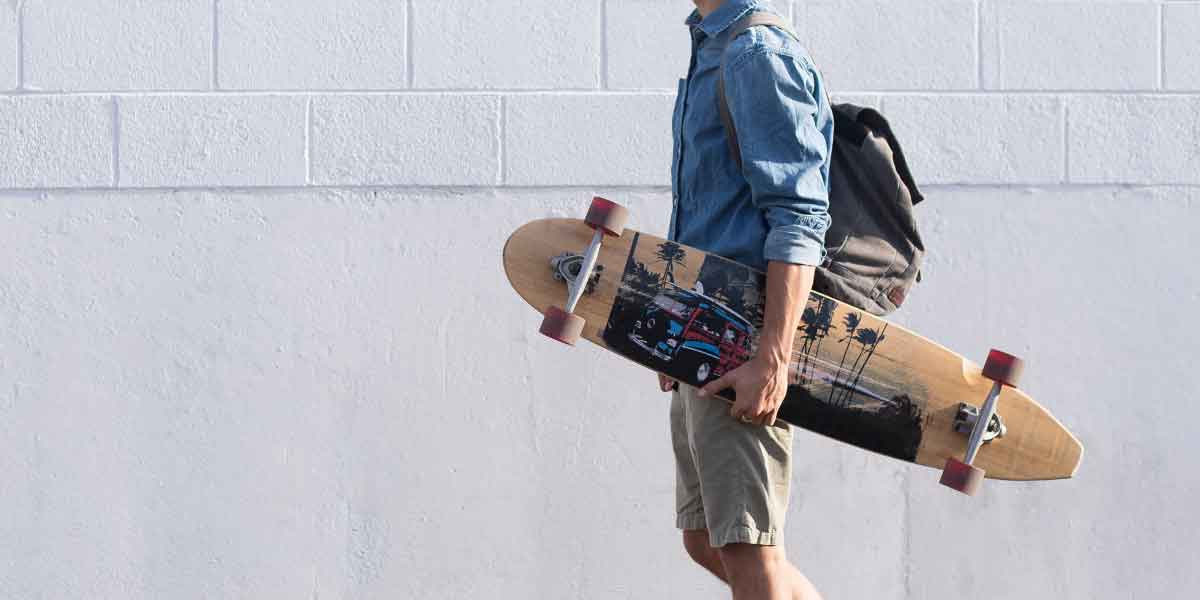A longboard skateboard is a type of skateboard that is designed for longer rides and smoother cruising. It typically has a longer and wider deck than a standard skateboard.
Longboard skateboards offer a unique experience compared to traditional skateboards. Not only that they are ideal for long-distance travel, downhill racing, and cruising. Longboards are also versatile and come in various shapes and sizes to suit different riding styles. Longboarding is a widely popular activity that combines adventure, fitness, and a sense of freedom.
Whether commuting or just enjoying a leisurely ride, longboards are a great choice for all skill levels. This article will help you explore everything you need about longboards.
A Brief History of Longboard
Longboarding started in the 1950s when Hawaiian surfers attached wheels to boards to mimic surfing on land. The sport gained traction in the 1970s with the invention of polyurethane wheels, improving ride quality. In the late 1990s and early 2000s, brands like Sector 9 and Loaded Boards revitalized longboarding by introducing advanced materials like bamboo and fiberglass. This led to a surge in popularity, especially for downhill racing and freestyle. Today, longboarding thrives worldwide, blending sport, art, and social connection.
What Is A Longboard?
A longboard is a type of skateboard with a longer and wider deck. This design makes it more stable and comfortable to ride. It’s perfect for various activities, like cruising through the city, carving turns, racing downhill, or performing tricks. It is a versatile choice for all types of riders.

Why is it called a longboard?
The name “longboard” comes from its longer deck compared to regular skateboards. Actually, longboards are 33 to 60 inches long. This extra length makes them ideal for cruising, downhill rides, and smooth turns. The design was inspired by surfboards, which are also long and built for flowing steady movement. Riders wanted to recreate the feeling of surfing on land, and the longer board allowed for that fluid experience. That’s why it’s called a “longboard” because of its length and connection to surfing.
What Makes a Longboard Unique?
A longboard skateboard is longer and wider than a traditional skateboard. These features enhance stability and control. Unlike trick skateboards, longboards are made for smooth rides, high speeds downhill, and traveling long distances. Here’s a short explanation of the main components:
Deck: The deck is typically 33 to 60 inches long and made from materials like bamboo, maple, or fiberglass. Longer decks provide more stability, while shorter ones offer increased agility.
Trucks: Trucks are the metal parts that connect the wheels to the deck. Longboards use wider trucks than skateboards, improving balance and control.
Wheels: Longboard wheels are bigger and softer, which helps to smooth out bumps and cracks. They provide a more comfortable ride compared to regular skateboard wheels.
Bearings: The bearings are small metal pieces inside the wheels. They help the wheels spin smoothly. Bearings are rated by ABEC scale. Higher ABEC ratings mean better precision and speed. Good bearings make a big difference in your ride.
Longboard Skateboard Materials
Longboards are usually made of different kinds of materials. Each material brings unique qualities to the table. They can influence everything from performance to durability.
Choosing the right material depends on your riding style and preferences. Knowing these materials helps you select a longboard that matches your needs perfectly. So try to learn about the longboard material whether you’re a beginner, a freestyle enthusiast, or a high-speed rider.
Wood remains a classic choice, with maple, bamboo, and oak being the most common. Maple offers durability and stiffness, ideal for tricks and high-speed cruising. Bamboo provides a flexible, lightweight ride with excellent shock absorption. On the other hand, oak is less flexible but highly durable, providing stability.
Composite materials like fiberglass and carbon fiber are popular for their enhanced performance. Fiberglass adds strength, smoothness, and flexibility. Carbon fiber is known for its strength-to-weight ratio. That’s why it delivers lightweight precision and durability.
Plastic longboards are budget-friendly and great for beginners. They’re lightweight, durable, and easy to maintain. They usually offer a smooth ride for casual use.

Types Of Longboards
Longboard skateboards come in various shapes and sizes. Each type serves a specific purpose and offers a unique riding experience. When you will understand the different types can help you choose the perfect longboard for your needs.
Cruisers are designed for smooth rides around town. These longboards are easy to maneuver and great for short commutes. They often have soft wheels which provide a smooth glide even on rough surfaces. Cruisers are perfect for beginners who want a comfortable ride.
Downhill boards are built for speed and stability. These boards have a stiff deck and a low center of gravity. This design helps maintain control at high speeds. Downhill boards often feature wider trucks for better stability. They are also suitable for experienced riders looking for adrenaline-pumping rides.
Freestyle boards are versatile and allow for various tricks and maneuvers. These boards have a symmetrical shape which makes it easy to ride in any direction. They usually have kicktails on both ends for performing tricks. Freestyle boards are really perfect for riders who love doing tricks and flips.
Dancing longboards are long and flexible, ideal for performing dance moves. These boards offer a large deck space which allows for footwork and spins. They are often lightweight and so are easy to control. Dancing boards are great for riders who enjoy fluid, artistic movements.
Basic Longboard Tricks for Beginners
Learning to ride a longboard skateboard can be exciting. Here are some basic tricks of longboard to help you get started. These basic tricks will make your experience more enjoyable.
Pushing Off: To start moving, place your front foot near the front of the board. Use your back foot to push against the ground while keeping your front foot steady. Push a few times to build speed, then place your back foot on the board once you have momentum.
Turning: To navigate your longboard, lean your body in the direction you want to turn. Lean left for a left turn and right for a right turn. Your board will follow your body’s movement. Start by practicing turns at slow speeds.
Stopping: Safe stopping is crucial. To stop, you can drag your back foot on the ground gently, which slows you down gradually. Alternatively, practice carving by making a series of small turns to reduce speed. You can also use the foot brake by placing one foot on the ground and pressing down to come to a stop.
When, and Where to Ride a Longboard
When to Ride a Longboard: Longboarding is great at any time of day! Early mornings and late afternoons offer cooler temperatures and fewer crowds. Weekends provide a chance for longer rides and exploring new spots. Just be sure to check the weather and avoid riding in heavy rain or strong winds to stay safe.
Where to Ride a Longboard: Pick the perfect spot based on your skill level. Beginners should start on smooth, flat surfaces like sidewalks or parks. As you improve, venture onto bike paths, boardwalks, or gentle hills. Advanced riders might enjoy thrilling downhill runs or dedicated longboarding areas. Always stay aware of your surroundings and follow local regulations to ensure a fun and safe ride.

How to Choose the Right Longboard for Your Skill Level
If you are able to choose the perfect longboard skateboard you will get some benefits. Here’s a straightforward guide to help you choose the right board based on your skill level and riding style.
For Beginners: If you’re just starting out, a cruiser or pintail longboard is your best bet. These boards offer stability and ease of control. So, it is ideal for learning the basics of longboarding. Their design helps you master essential skills like pushing off, turning, and stopping with confidence.
For Intermediate Riders: As you gain experience, you might want to try a freeride or freestyle longboard. These boards are versatile, speedy, and good for tricks. They offer more maneuverability to help you refine your skills and styles.
For Advanced Riders: If you’re an adrenaline junkie, a downhill longboard is perfect for high-speed thrills. These boards are stiffer and designed for stability during fast descents. They provide the control and responsiveness for tackling steep hills and performing advanced maneuvers.
Joining The Longboarding Community
Joining the longboarding community is an exciting journey. You’ll meet new friends, learn new skills, and enjoy the fun of riding. The community is welcoming and diverse so that beginners can feel it like home.
Local clubs are a great way to meet fellow longboarders.
Online forums are perfect for connecting with longboarders from around the world.
Events and competitions offer a chance to prove your skills and learn from others.
Environmental Impact of Longboarding
Longboarding is a fun sport, but it also affects the environment. To reduce this impact, consider the following tips. Choose longboards made from sustainable wood, eco-friendly composites, or recycled plastics. These materials help lessen the environmental footprint. Durable boards are another great choice; they last longer and reduce the need for frequent replacements.
Additionally, support brands that offer recycling programs to manage waste better. Also, local production and eco-friendly transportation methods can cut down on emissions. These small choices let you enjoy longboarding while helping the planet
Conclusion
Longboard skateboards offer a unique and enjoyable way to cruise around. They provide stability and ease of use for all riders. Whether you’re commuting or just having fun, longboards are a great choice. Discover the joy of longboarding and experience the thrill today.
Please stay safe and enjoy your ride!
Frequently Asked Questions
What Is A Longboard Skateboard?
A longboard skateboard is a type of skateboard with a longer, wider deck. It’s designed for cruising, downhill racing, and long-distance riding.
How Does A Longboard Skateboard Differ From A Regular Skateboard?
A longboard is longer and more stable than a regular skateboard. It offers better balance and is ideal for cruising and downhill riding.
What Are The Benefits Of Riding A Longboard?
Riding a longboard provides better stability, and smoother rides, and is great for long-distance travel. It’s really perfect for both beginners and experienced riders.
What Types Of Longboards Are Available?
There are various types of longboards, including cruiser boards, downhill boards, and freestyle boards. Each type suits different riding styles and preferences.

